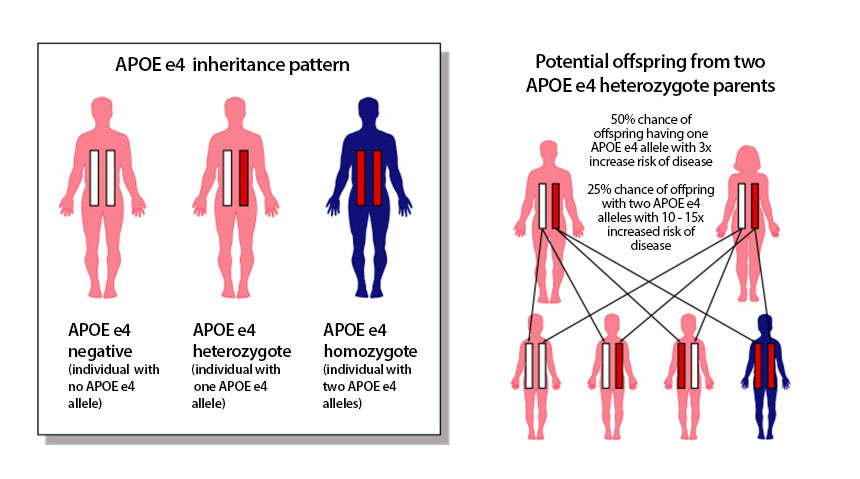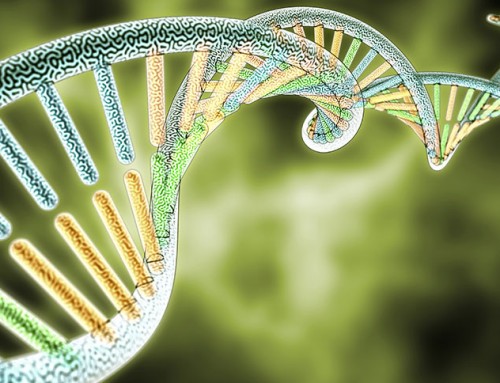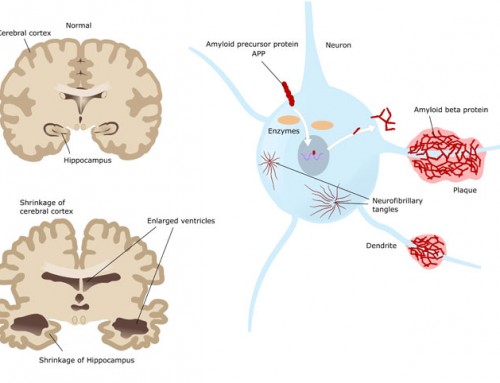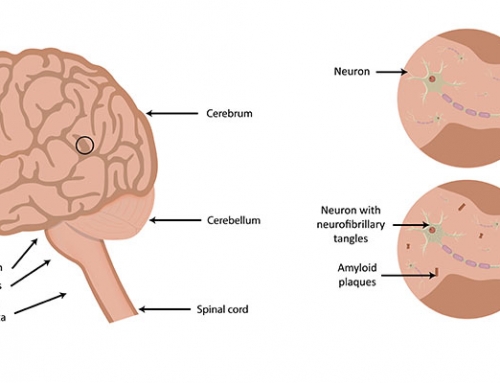How is the Alzheimer’s Disease APOE Gene Inherited?
The APOE gene linked to Late-Onset Alzheimer’s disease is present on one of the autosomal chromosomes (chromosome 19). Each of us inherits one of each autosomal chromosome from each parent, and if we have children, we pass one of each autosomal chromosome to the next generation. So this means, if you have two identical copies of the APOE gene (homozygote), each of your parents has at least one copy of the same allele, and you will pass that allele to all of your children.
For example, if you are an APOE e4 homozygote, both of your parents must also carry at least one copy of APOE e4 and all of your children will inherit at least one copy of APOE e4. However, from just your own genetic analysis, it is not possible to determine what second allele your parents carry without testing your parents. Likewise, couples wishing to determine the risk of having children affected with two copies of APOE e4 must test both partners, even if one partner is a confirmed APOE e4 homozygote.
Another example is an APOE e2/e4 heterozygote. This person has inherited the increased risk APOE e4 allele from one parent and the decreased risk APOE e2 allele from the other parent, but it is not possible to determine which allele came from each parent without testing the parents. There is a 50% chance that an individual who is a APOE e2/e4 heterozygote will pass the APOE e4 allele to the next generation. It must be remembered that this probability remains the same for each child, so each child will have a 50% chance of inheriting the increased risk APOE e4 allele. If two parents are both APOE e2/e4 heterozygotes, there is a 25% chance that each of their children will inherit two APOE e2 alleles, a 50% chance that they will also be an APOE e2/e4 heterozygote and a 25% chance that they will inherit two APOE e4 alleles.
Undertaking a genetic analysis, such as this APOE DNA test, must be treated with caution as testing an individual who takes the APOE DNA test to determine their own risk of developing Alzheimer’s Disease can sometimes inadvertently gain some information on the risk of the their parents as well as their children. This can cause complications within families, as some people would prefer not to know if they are at an increased risk of Alzheimer’s disease.
Another important thing to remember is that this genetic analysis only gives an indication of increased or decreased risk of Alzheimer’s disease. Luckily there are some APOE e4 homozygotes who never develop Alzheimer’s, but unfortunately there are also some people who do develop Alzheimer’s, despite not carrying the increased risk APOE e4 allele. It is also important to note that theAPOE e4 is associated with Late-Onset Alzheimer’s Disease, which accounts for over 90% of Alzheimer’s Disease patients. The second, more rare form of Alzheimer’s Disease is known as Early-Onset Alzheimer’s Disease. Although there is some evidence that the APOE e4 allele is also associated with an increased risk of Early-Onset Alzheimer’s, changes in the PSEN1, PSEN2 and APP genes are more common indicators of the Early-Onset disease.
References:
Cauwenberghe CV, Broeckhoven CV, Sleegers K (2016). The genetic landscape of Alzheimer disease: clinical implications and perspectives. Genetics in Medicine, 18(5): 421-430.
Goldman JS, Hahn SE, Catania JW, LaRusse-Eckert S, Butson MB, Rumbaugh M, … Bird T (2011). Genetic Counseling and Testing for Alzheimer Disease: Joint Practice Guidelines of the American College of Medical Genetics and the National Society of Genetic Counselors. Genetics in Medicine, 13(6): 597-605.
Hollingworth P, Green RC (reviewed July 2012). Genetics of dementia.
Genovate Laboratories2017-04-06T00:20:01+00:00






